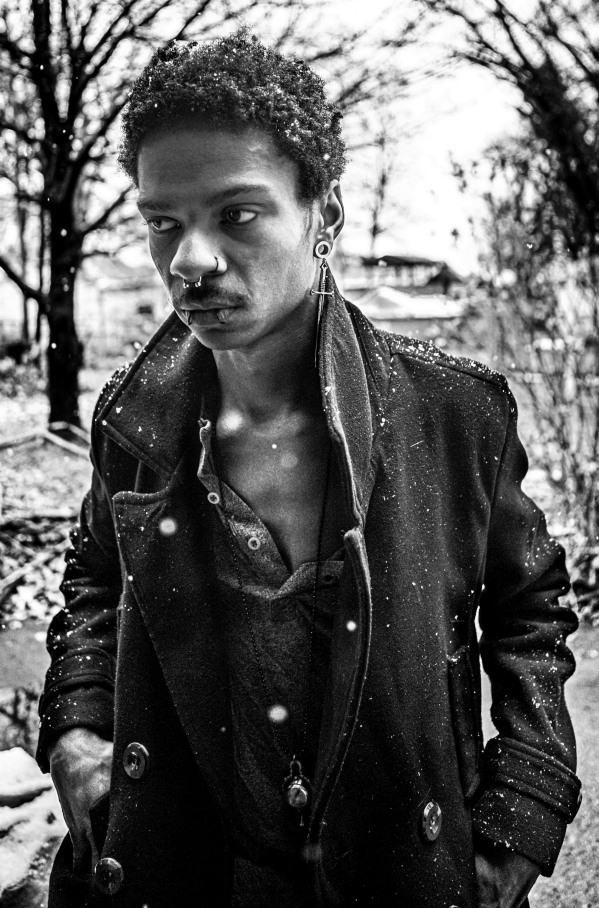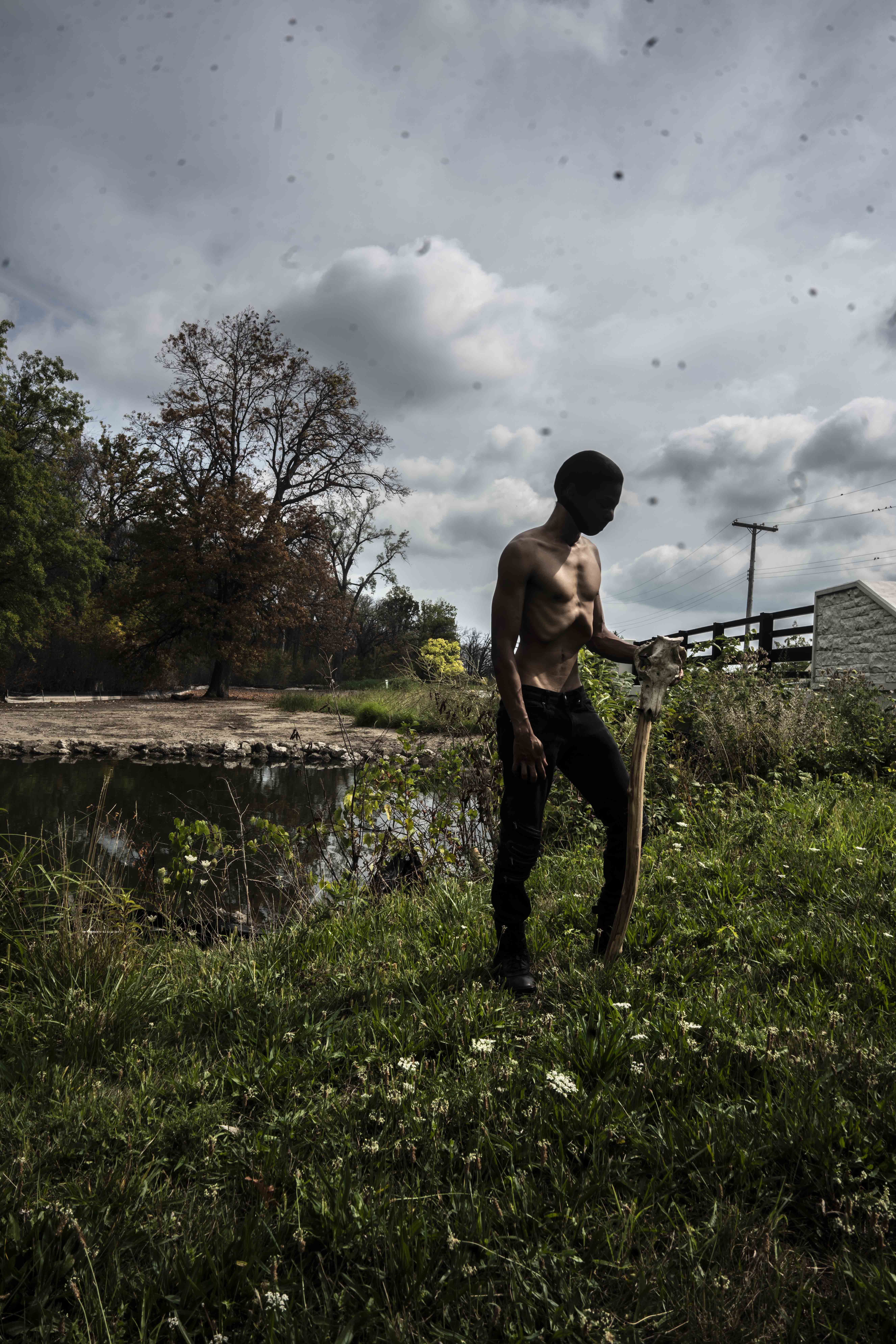You use many different, interesting and diverse models in your work. Who are they? Do you choose the models and put them in a setting or find the setting and then the model who fits that scene or point-of-view?
I work with models based on my pre-visualization. Once I have a scene in mind I look for models who most accurately represent that vision. Often times I will scout areas alone, days, weeks, months, and sometimes even years in advance just to imagine model placement before I search for a person to fit into the image. Sometimes it takes years to find the person who fits into a particular image.
What motivates your work?
I want to show the beauty of things that are in the world currently. Ever since that first time when my pictures started a discussion about the meaning behind them, I knew I could get my point across. I see beauty all the time in everything and I believe everyone could, too, if we just pay enough attention to it. We’re caught up in our day-to-day lives and to really appreciate and to be present is just a different way of life. It’s more than just routine. Even if it’s just making a slight deviation in your day, I hope to stimulate people’s imaginations, I guess.
You do all your shooting of what you call ruins and decay in Detroit. Why there, and why those themes?
I was born and raised here. This is my home. I want everyone to take the time to look around. This place is beautiful. My work combines the surreal with urban grunge. This place is gritty and grungy and dreamlike. I want people to see the beauty in a weed growing in concrete.
That’s the theme of an ongoing project I’m working on called “Urban Fantasy.” I’m trying something with limited designs. Each time I print it will be one of a kind.
I work with models based on my pre-visualization. Once I have a scene in mind I look for models who most accurately represent that vision. Often times I will scout areas alone, days, weeks, months, and sometimes even years in advance just to imagine model placement before I search for a person to fit into the image. Sometimes it takes years to find the person who fits into a particular image.
What motivates your work?
I want to show the beauty of things that are in the world currently. Ever since that first time when my pictures started a discussion about the meaning behind them, I knew I could get my point across. I see beauty all the time in everything and I believe everyone could, too, if we just pay enough attention to it. We’re caught up in our day-to-day lives and to really appreciate and to be present is just a different way of life. It’s more than just routine. Even if it’s just making a slight deviation in your day, I hope to stimulate people’s imaginations, I guess.
You do all your shooting of what you call ruins and decay in Detroit. Why there, and why those themes?
I was born and raised here. This is my home. I want everyone to take the time to look around. This place is beautiful. My work combines the surreal with urban grunge. This place is gritty and grungy and dreamlike. I want people to see the beauty in a weed growing in concrete.
That’s the theme of an ongoing project I’m working on called “Urban Fantasy.” I’m trying something with limited designs. Each time I print it will be one of a kind.
Artist Interview
Andrew Ross Evans . . .
“I want to show the beauty of things that are in the world currently”
How did you get started?
At age 13 I started shooting as a hobby, landscapes and still life, no models or people at that point. I had a basic digital point-and-shoot camera, and I did it for fun. It was a little different, but it felt familiar. Composition and lighting just came to me. I had a pre-disposition for it,
I guess. Then when I was 16, I got my first film camera. It was my mother’s Cannon Rebel. I was able to manipulate things manually.
You have said you don’t use Photoshop or computer manipulation on your images. Why not take advantage of the new methods?
I prefer to use optical illusions and good solid darkroom techniques to create effects. Some of the things I do simply involve shooting at the right moment. I use a lot of fishing line to suspend things and to pull off “magical tricks,” and use other effects like smoke bombs placed inside of things or coming out of somebody’s clothing.
At age 13 I started shooting as a hobby, landscapes and still life, no models or people at that point. I had a basic digital point-and-shoot camera, and I did it for fun. It was a little different, but it felt familiar. Composition and lighting just came to me. I had a pre-disposition for it,
I guess. Then when I was 16, I got my first film camera. It was my mother’s Cannon Rebel. I was able to manipulate things manually.
You have said you don’t use Photoshop or computer manipulation on your images. Why not take advantage of the new methods?
I prefer to use optical illusions and good solid darkroom techniques to create effects. Some of the things I do simply involve shooting at the right moment. I use a lot of fishing line to suspend things and to pull off “magical tricks,” and use other effects like smoke bombs placed inside of things or coming out of somebody’s clothing.

At age 13 I started shooting as a
hobby, landscapes and still life, no
models or people at that point. I
had a basic digital point-and-shoot
camera, and I did it for fun. It was
a little different, but it felt familiar.
Composition and lighting just came
to me. I had a pre-disposition for
it, I guess. Then when I was 16, I
got my first film camera. It was
my mother’s Cannon Rebel. I was able to manipulate things
manually.
At age 13 I started shooting as a hobby,
landscapes and still life, no models or people at
that point. I had a basic digital point-and-shoot
camera, and I did it for fun. It was a little
different, but it felt familiar. Composition and
lighting just came to me. I had a pre-disposition
for it, I guess. Then when I was 16, I got my
first film camera. It was my mother’s Cannon
Rebel. I was able to manipulate things
manually.


I want to show the beauty of things that are in the world currently.
Ever since that first time when my pictures started a
discussion about the meaning behind them, I knew I
could get my point across. I see beauty all the time
in everything and I believe everyone could, too, if we
just pay enough attention to it. We’re caught up in
our day-to-day lives and to really appreciate and to
be present is just a different way of life. It’s more
than just routine. Even if it’s just making a slight
deviation in your day, I hope to stimulate people’s
imaginations, I guess.
I want to show the beauty of things that are in the world currently. Ever since that first
time when my pictures started a discussion about the meaning
behind them, I knew I could get my point across. I see beauty all
the time in everything and I believe everyone could, too, if we just
pay enough attention to it. We’re caught up in our day-to-day lives
and to really appreciate and to be present is just a different way of
life. It’s more than just routine. Even if it’s just making a slight
deviation in your day, I hope to stimulate people’s imaginations, I
guess.
I was born and raised here. This is my home. I want everyone to
take the time to look around. This place is beautiful. My work
combines the surreal with urban grunge. This place is gritty and
grungy and dreamlike. I want people to see the beauty in a weed
growing in concrete.
That’s the theme of an ongoing project I’m working on called “Urban
Fantasy.” I’m trying something with limited designs. Each time I
print it will be one of a kind.
I was born and raised here. This is my home. I want everyone to take the
time to look around. This place is beautiful. My work combines the surreal
with urban grunge. This place is gritty and grungy and dreamlike. I want
people to see the beauty in a weed growing in concrete.
That’s the theme of an ongoing project I’m working on called “Urban
Fantasy.” I’m trying something with limited designs. Each time I print it
will be one of a kind.
How did you get started?
You have said you don’t use Photoshop or computer manipulation on your images. Why not take advantage of the new methods?
You use many different, interesting and diverse models in your work. Who are they? Do you choose the models and put them in a setting or find the setting and then the model who fits that scene or point-of-view?
I prefer to use optical illusions and good solid darkroom techniques
to create effects. Some of the things I do simply involve shooting at
the right moment. I use a lot of fishing line to suspend things and
to pull off “magical tricks,” and use other effects like smoke bombs
placed inside of things or coming out of somebody’s clothing.
I prefer to use optical illusions and good solid darkroom techniques to
create effects. Some of the things I do simply involve shooting at the right
moment. I use a lot of fishing line to suspend things and to pull off
“magical tricks,” and use other effects like smoke bombs placed inside of
things or coming out of somebody’s clothing.
I work with models based on my pre-visualization. Once I have a
scene in mind I look for models who most accurately represent that
vision. Often times I will scout areas alone, days, weeks, months,
and sometimes even years in advance just to imagine model
placement before I search for a person to fit into the image.
Sometimes it takes years to find the person who fits into a particular
image
I work with models based on my pre-visualization. Once I have a scene in
mind I look for models who most accurately represent that vision. Often
times I will scout areas alone, days, weeks, months, and sometimes even
years in advance just to imagine model placement before I search for a
person to fit into the image. Sometimes it takes years to find the person
who fits into a particular image
What motivates your work?
You do all your shooting of what you call ruins and decay in Detroit. Why there, and why those themes?